Abstract
Some transitions between ordered and disordered magnetic states that take place via transitions of first order are tabulated. Among these transitions are some of the order-disorder type. The theoretical basis for such a transition to occur is indicated using a simple physical model that assumes: (1) a strain dependent exchange interaction and (2) a compressible lattice. The necessary condition for first-order behavior is determined, and the theory is compared to the behavior of a real material, MnAs. It is found to be in substantial agreement with the behavior of that compound. The system represented by the simple model employed here possesses ferro-, antiferro-, and paramagnetic states. The equilibrium boundaries between these states are determined in the pressure-temperature plane as an illustration of the possible transitions that may be observed with this model.
Access this chapter
Tax calculation will be finalised at checkout
Purchases are for personal use only
Preview
Unable to display preview. Download preview PDF.
Similar content being viewed by others
References
T. J. Swoboda, W. H. Cloud, T. A. Bither, M. S. Sadler, and H. S. Jarrett, Phys. Rev. Letters 4, 509 (1960).
C. Kittel, Phys. Rev. 120, 335 (1960).
Some earlier considerations of transitions between ordered spin states have been given by: J. S. Smart, Phys. Rev. 90, 55 (1953)
L. Néel, Compt. rend. 242, 1824 (1956)
G. W. Pratt Jr., Phys. Rev. 108, 1233 (1957)
and S. H. Liu, D. R. Behrendt, S. Legvold, and R. H. Good, Phys. Rev. 116, 1464 (1959).
A. Yoshimori, J. Phys. Soc. Japan 14, 807 (1959).
J. Villain, J. Chem. Phys. Solids 11, 303 (1959).
T. A. Kaplan, K. Dwight, D. Lyons, and N. Menyuk, J. Appl. Phys. 32, 13S (1961).
T. A. Kaplan, Phys. Rev. 124, 329 (1961).
R. J. Elliott, Phys. Rev. 124, 346 (1961).
K. Yosida and H. Miwa, J. Appl. Phys. 32, 8S (1961).
A. Serres, J. phys. radium 8, 146 (1947).
B. T. M. Willis and H. P. Rooksby, Proc. Phys. Soc. (London) B67, 290 (1954).
Author information
Authors and Affiliations
Editor information
Rights and permissions
Copyright information
© 1962 Springer Science+Business Media New York
About this paper
Cite this paper
Rodbell, D.S., Bean, C.P. (1962). Some Magnetic First-Order Transitions. In: Osborn, J.A. (eds) Proceedings of the Seventh Conference on Magnetism and Magnetic Materials. Springer, Boston, MA. https://doi.org/10.1007/978-1-4899-6391-8_5
Download citation
DOI: https://doi.org/10.1007/978-1-4899-6391-8_5
Publisher Name: Springer, Boston, MA
Print ISBN: 978-1-4899-6193-8
Online ISBN: 978-1-4899-6391-8
eBook Packages: Springer Book Archive




